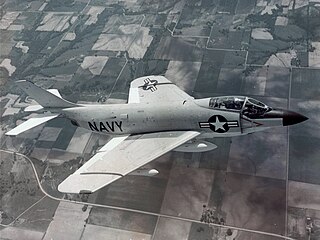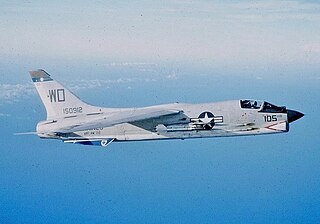
The McDonnell FH Phantom is a twinjet fighter aircraft designed and first flown during World War II for the United States Navy. The Phantom was the first purely jet-powered aircraft to land on an American aircraft carrier and the first jet deployed by the United States Marine Corps. Although only 62 FH-1s were built it helped prove the viability of carrier-based jet fighters. As McDonnell's first successful fighter, it led to the development of the follow-on F2H Banshee, which was one of the two most important naval jet fighters of the Korean War; combined, the two established McDonnell as an important supplier of navy aircraft.

The McDonnell F2H Banshee is a single-seat carrier-based jet fighter aircraft designed and produced by the American aircraft manufacturer McDonnell Aircraft. It was an early jet fighter operated by United States Navy and United States Marine Corps, as well as being the only jet-powered fighter to ever be deployed by the Royal Canadian Navy. The aircraft's name is derived from the banshee of Irish mythology.

The McDonnell F3H Demon is a subsonic swept-wing carrier-based jet fighter aircraft designed and produced by the American manufacturer McDonnell Aircraft Corporation. It was the first swept wing jet fighter and the only single-engined carrier-based fighter the company produced.

The Vought F-8 Crusader is a single-engine, supersonic, carrier-based air superiority jet aircraft designed and produced by the American aircraft manufacturer Vought. It was the last American fighter that had guns as the primary weapon, earning it the title "The Last of the Gunfighters".

The Republic F-84 Thunderjet was an American turbojet fighter-bomber aircraft. Originating as a 1944 United States Army Air Forces (USAAF) proposal for a "day fighter", the F-84 first flew in 1946. Although it entered service in 1947, the Thunderjet was plagued by so many structural and engine problems that a 1948 U.S. Air Force review declared it unable to execute any aspect of its intended mission and considered canceling the program. The aircraft was not considered fully operational until the 1949 F-84D model and the design matured only with the definitive F-84G introduced in 1951. In 1954, the straight-wing Thunderjet was joined by the swept-wing F-84F Thunderstreak fighter and RF-84F Thunderflash photo reconnaissance aircraft.

The North American AJ Savage is an American carrier-based medium bomber built for the United States Navy by North American Aviation. The aircraft was designed shortly after World War II to carry atomic bombs and this meant that the bomber was the heaviest aircraft thus far designed to operate from an aircraft carrier. It was powered by two piston engines and a turbojet buried in the rear fuselage. The AJ-1 first became operational in 1950 and several were based in South Korea during 1953 as a deterrent against North Korea. Of the 140 built, plus three prototypes, 30 were reconnaissance aircraft. Inflight-refueling equipment was deployed on the Savage in the mid-1950s. The bomber was replaced by the Douglas A3D Skywarrior beginning in 1957. The type was used after its military service for some additional experiments including microgravity test flights and to test a new jet engine in the 1960s and 70s.

The LTV A-7 Corsair II is an American carrier-capable subsonic light attack aircraft designed and manufactured by Ling-Temco-Vought (LTV).

The Grumman F11F/F-11 Tiger is a supersonic, single-seat carrier-based fighter aircraft designed and produced by the American aircraft manufacturer Grumman. For a time, it held the world altitude record of 76,939 feet (23,451 m), as well as being the first supersonic fighter to be produced by Grumman.

The North American FJ-2 and FJ-3 Fury are a series of swept-wing and carrier-capable fighters for the United States Navy and Marine Corps. The FJ-2 resulted from an effort to navalize the North American F-86 Sabre operated by the United States Air Force. These aircraft feature folding wings, and a longer nose landing strut designed to increase angle of attack upon launch and to accommodate a longer oleo to absorb the shock of hard landings on an aircraft carrier deck.

The Douglas F4D Skyray is an American carrier-based fighter/interceptor designed and produced by the Douglas Aircraft Company. It was the last fighter produced by the Douglas Aircraft Company prior to its merger with McDonnell Aircraft to become McDonnell Douglas.

The North American T-2 Buckeye was the United States Navy's intermediate training aircraft, intended to introduce U.S. Navy and U.S. Marine Corps student naval aviators and student naval flight officers to jets. It entered service in 1959, beginning the replacement process of the Lockheed T2V SeaStar, and was itself replaced by the McDonnell Douglas T-45 Goshawk in 2008.

The Ryan FR Fireball was an American mixed-power fighter aircraft designed by Ryan Aeronautical for the United States Navy during World War II. It was the Navy's first aircraft with a jet engine. Only 66 aircraft were built before Japan surrendered in August 1945. The FR-1 Fireball equipped a single squadron before the war's end, but did not see combat. The aircraft ultimately proved to lack the structural strength required for operations aboard aircraft carriers and was withdrawn in mid-1947.

The Vought F7U Cutlass was a United States Navy carrier-based jet fighter and fighter-bomber designed and produced by the aircraft manufacturer Chance Vought. It was the first tailless production fighter in the United States as well as the Navy's first jet equipped with swept wings and the first to be designed with afterburners.

The North American F-107 is North American Aviation's entry in a United States Air Force tactical fighter-bomber design competition of the 1950s, based on the F-100 Super Sabre. It incorporated many innovations and radical design features, notably the over-fuselage air intakes. The competition was eventually won by the Republic F-105 Thunderchief, and two of the three F-107 prototypes ended their lives as test aircraft. One is on display at the National Museum of the United States Air Force and a second at Pima Air and Space Museum.

The General Electric/Allison J35 was the United States Air Force's first axial-flow compressor jet engine. Originally developed by General Electric in parallel with the Whittle-based centrifugal-flow J33, the J35 was a fairly simple turbojet, consisting of an eleven-stage axial-flow compressor and a single-stage turbine. With the afterburner, which most models carried, it produced a thrust of 7,400 lbf (33 kN).

The Yakovlev Yak-19 was a prototype Soviet fighter built in the late 1940s. It was the first Soviet aircraft to be equipped with an afterburning turbojet, the Klimov RD-10F that was derived from the German Jumo 004 engine. Only two examples were built as it was rejected for service by the Soviet Air Force.

The North American F-86D/K/L Sabre was an American transonic jet interceptor. Developed for the United States Air Force in the late 1940s, it was an interceptor derivative of the North American F-86 Sabre. While the original F-86 Sabre was conceived as a day fighter, the F-86D was specifically developed as an all-weather interceptor. Originally designated as the YF-95 during development and testing, it was re-designated the F-86D before production began, despite only sharing 25% commonality of parts with the original F-86. Production models of the F-86D/K/L differed from other Sabres in that they had a larger fuselage, a larger afterburning engine, and a distinctive nose radome. The most-produced Sabre Dog variants also mounted no guns, unlike the Sabre with its six M3 Browning .50 caliber machine guns, instead mounting unguided “Mighty Mouse” air-to-air rockets.

The Vought F6U Pirate was the Vought company's first jet fighter, designed for the United States Navy during the mid-1940s. Although pioneering the use of turbojet power as the first naval fighter with an afterburner and composite material construction, the aircraft proved to be underpowered and was judged unsuitable for combat. None were ever issued to operational squadrons and they were relegated to development, training, and test roles before they were withdrawn from service in 1950.

The North American FJ-4 Fury is a swept-wing carrier-capable fighter-bomber for the United States Navy and Marine Corps. The final development in a lineage that included the Air Force's F-86 Sabre, the FJ-4 shared its general layout and engine with the earlier FJ-3, but featured an entirely new wing design and was a vastly different design in its final embodiment.

























